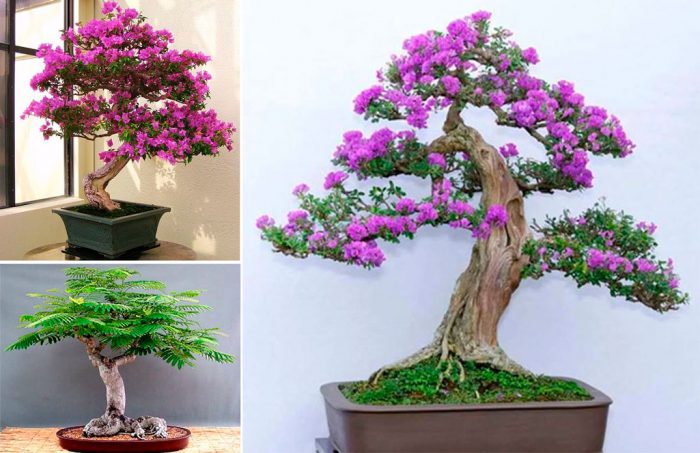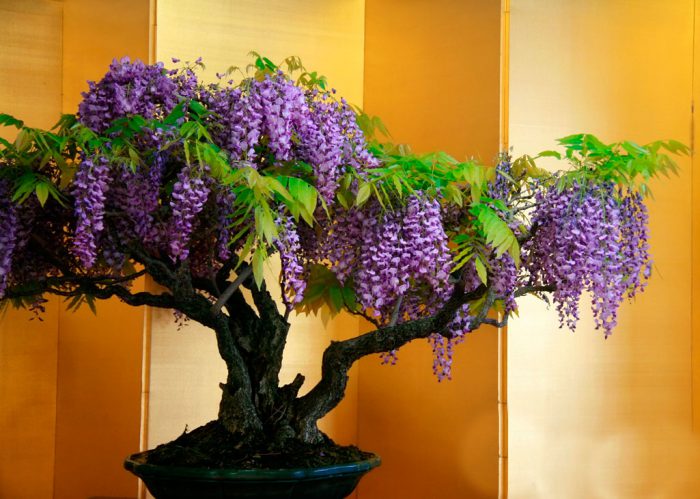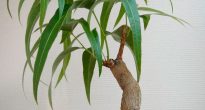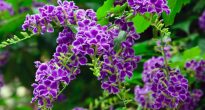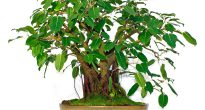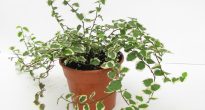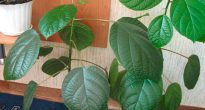A plant like jacaranda (Jacaranda) is directly related to the bignonium family. This genus unites about 50 species of various plants. In some sources, this flower is called jaccaranda. It occurs naturally in tropical regions of South America.
This plant is represented by herbaceous perennials, trees, and shrubs. The opposite leaves are pinnate. The inflorescences are at the top of the shoots and look like a panicle, or they grow from the leaf sinuses. Tubular flowers are blue or lilac.
There are many species that have very valuable wood, besides the plants themselves have a very spectacular appearance. Only young plants are suitable for growing at home.
Content
Jacaranda home care
Illumination
It needs bright light, so it is recommended to place it near an east or west orientation window. If you place the jacaranda next to the southern window, then it will need to be shaded from the direct rays of the sun at midday. However, there is an opinion that it is very useful for a plant to be in direct sunlight for a couple of hours a day. A newly acquired plant must be taught to bright light gradually, otherwise burns may form on the leaves. In the same way, the tree should be accustomed to bright light even after the prolonged cloudy weather ends. To form a beautiful crown, you need to regularly turn the pot little by little around its axis. If this is not done, then it is deformed to one side.
Temperature regime
Heat-loving plant. So, from the beginning of the spring to the middle of the autumn period, the tree needs a temperature of 22-24 degrees. In winter, it needs a relative coolness of 16 to 19 degrees.
How to water
It is necessary to water the plant systematically, and this procedure is performed immediately after the top layer of soil in the pot has dried. During the winter and at the beginning of the spring period (when the leaves change), it is necessary to water much less and at the same time it is imperative to ensure that the soil does not dry out. For watering, you should use well-settled and always soft water.
Humidity
Requires high humidity. To increase it, it is recommended to pour a little expanded clay into the pan and pour in water. Also, the tree needs daily spraying with lukewarm water.
Fertilizer
In the spring-summer period, it is imperative to carry out regular feeding of the jacaranda a little more often than once a month. For this, a complex mineral fertilizer is used. In winter, fertilizers cannot be applied to the soil. Also, this should not be done while the plant is shedding foliage.
Foliage features
This plant completely sheds its foliage in winter or at the very beginning of spring. Moreover, this process is natural and does not depend on the intensity of illumination. After that, young leaves begin to grow on the tree. Over the years, jacaranda loses its decorative effect, since its lower branches are completely bare.
Pruning
In springtime, the tree needs to pinch the tips of the shoots. This is necessary to form a very spectacular and beautiful crown. Gradually, the trunk becomes bare, because jacaranda is a fairly fast-growing plant.
Transplant features
The transplant is carried out in the spring after the root system ceases to fit in the flower pot. To prepare a suitable soil mixture, it is necessary to take sod and humus soil, as well as sand and peat in a ratio of 2: 1: 1: 1. Also, for planting, you can use a soil mixture consisting of humus, peat, leaf, turf soil and sand, which should be taken in a ratio of 2: 2: 4: 2: 1. Make sure to make a good drainage layer at the bottom of the pot.
Reproduction methods
In springtime, this plant is quite possible to grow from seeds. Before sowing, the seeds are placed in a moistened cloth for 24 hours. The seeds are covered with a centimeter layer of soil, and then it is well watered. If the temperature is kept constant at 22-24 degrees, the first shoots will appear 14-20 days after sowing. The seedlings that appear should be placed in a well-lit place. Grown seedlings must be dived into small separate pots (7 centimeters in diameter). For transplanting, you must use a soil mixture consisting of peat, turf and humus soil, as well as sand, taken in a ratio of 1: 2: 1: 1. With each subsequent transplant, the pots are taken slightly larger (with a diameter of 9 centimeters, then 11 centimeters).
In the period from May to July, this plant can be propagated by cuttings.
Diseases and pests
Can settle spider mite or shield.
Falling all foliage - normal process. So, the foliage falls off the plant in winter, and young leaves begin to grow in the spring.
Main types
Jacaranda mimosifolia
It is also called oval-leaf jacaranda (Jacaranda ovalifolia) - it prefers to grow on the banks of rivers in the south of Argentina and Brazil, Bolivia. However, it grows only on well-drained soil. Under natural conditions, this tree is quite tall, but when grown at home, it reaches a height of only 3 meters. Has an unbranched straight trunk. The leaves are located at a relative distance from each other, which contributes to the formation of a very effective crown. Feathery, oppositely located rather large leaves have petioles, which begin to fall over the years. The leaf plate itself has an elongated lanceolate shape, while it has a narrowed base and a pointed tip. The inflorescence has the shape of a panicle. In length, the flowers reach 5 centimeters, and in diameter are equal to 3 centimeters. They are painted blue and have whitish spots on the surface.
Fluffy Jacaranda (Jacaranda tomentosa)
Also called jasmine jacaranda (Jacaranda jasminoides) - occurs naturally in South America, and grows up to 15 meters in height. The pinnate leaflets consist of four pairs of leaf blades, which, in turn, are divided into 4–5 pairs of ovoid lobes. The flowers, painted in purple, are attached to the paniculate inflorescence. This tree looks very impressive at home, but only young specimens are suitable for growing.

